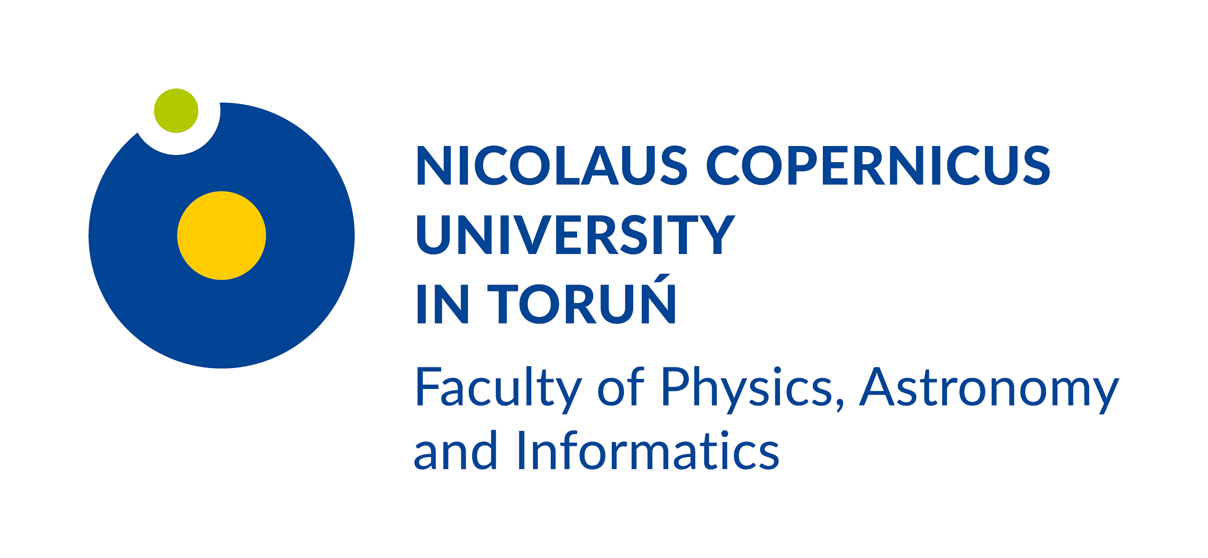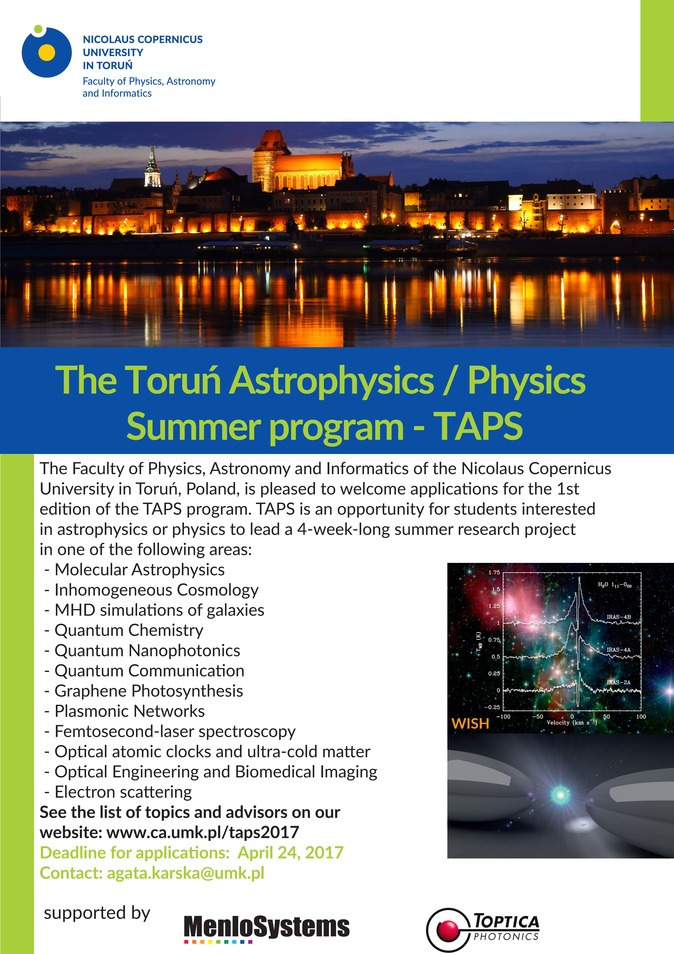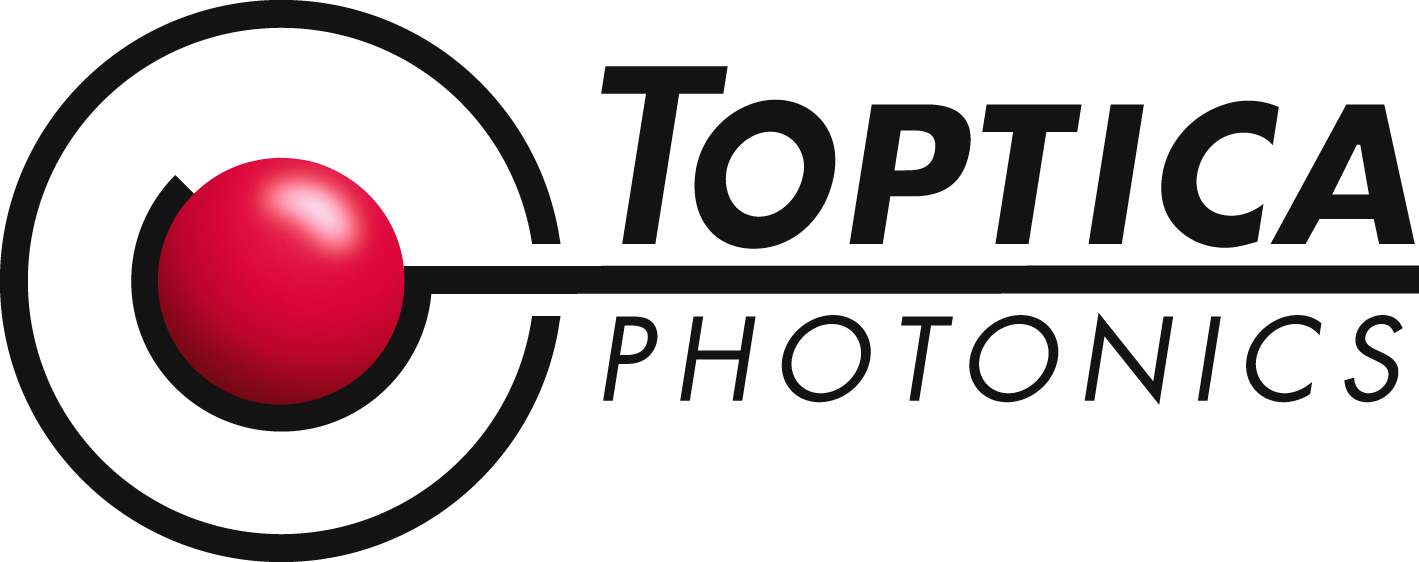TAPS 2017 projects
The main component of the summer program is an active participation in the selected astrophysics / physics research project offered by the staff members of the Nicolaus Copernicus University, please see the topics and their descriptions below. Interested students are welcome to contact possible advisors for more details concerning the foreseen projects and discuss the dates that the project could be undertaken.
Sunbathing around protostars
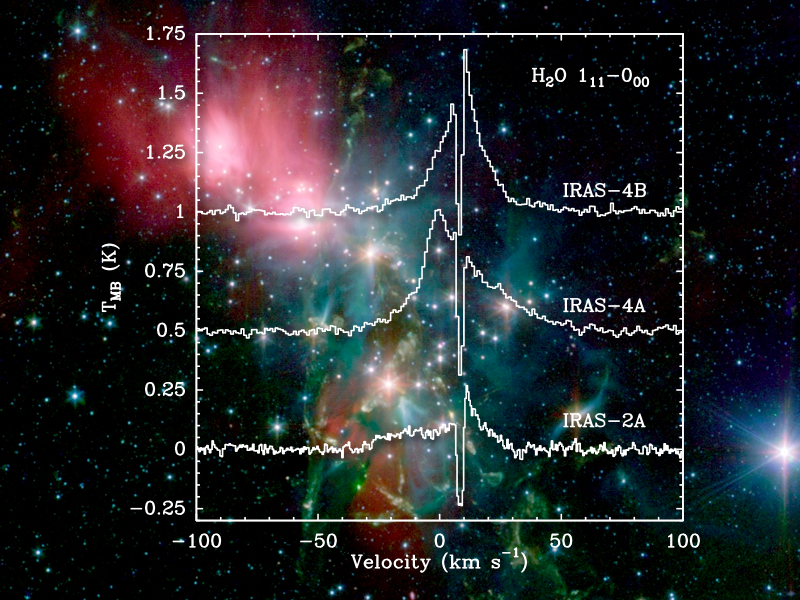
Stars form in dense molecular clouds, where gas and dust are well-shielded from the interstellar UV radiation. Nonetheless, UV photons can be produced in situ in the surroundings of young protostars: either by the accretion of material onto the disk or its partial ejection in the powerful jets. Recent observations with the Herschel Space Telescope reveal that even relatively small UV fields dramatically change the chemical composition of the gaseous envelopes.
The student will have an opportunity to reduce and analyse maps of molecular emission around protostars and compare them to new, state-of-the-art models including the role of UV photons.The data was obtained by far-infrared space telescope Herschel and single-dish submillimeter telescope IRAM.
^ ^ ^ ^ ^
Rotation Curve of the Milky Way
Spiral galaxies, the most popular ones in the Universe, apparently rotate. Our Galaxy, the Milky Way system, cannot be observed from an outside. Thus outlining the structure of the Galaxy, believed to be spiral, may be barred, is possible only by means of measuring distances to various objects and their radial velocities. It is also possible to apply proper motions but this requires much more time. In 1928 Otto Struve proposed that column densities of interstellar gas may be related to distances to the observed objects. This idea was developed in Toruń during the last decade, using for calibration satellite parallaxes. Interstellar lines of CaII (the first interstellar features ever discovered - 1904) allow to measure distances and radial velocities from the same spectra.
The existing database of high resolution, echelle spectra, allows to make measurements of intensities and radial velocities of hundreds of stars seen from both Northern and Southern hemispheres.
The program would include such measurements for a substantial sample of Milky Way disc objects. Comparing the measurements of distances and radial velocities with models of our Galaxy rotation one can determine the Milky Way rotation curve. This should allow to check whether orbits of galactic objects are keplerian or flat.
The second case may indicate for the presence of dark matter halo around the Galaxy; the first - that there is no dark matter in our vicinity. This is the first attempt to outline the (spiral) structure of the Milky Way disc using not stars and their aggregates but interstellar clouds.
^ ^ ^ ^ ^
MHD simulations of galaxies
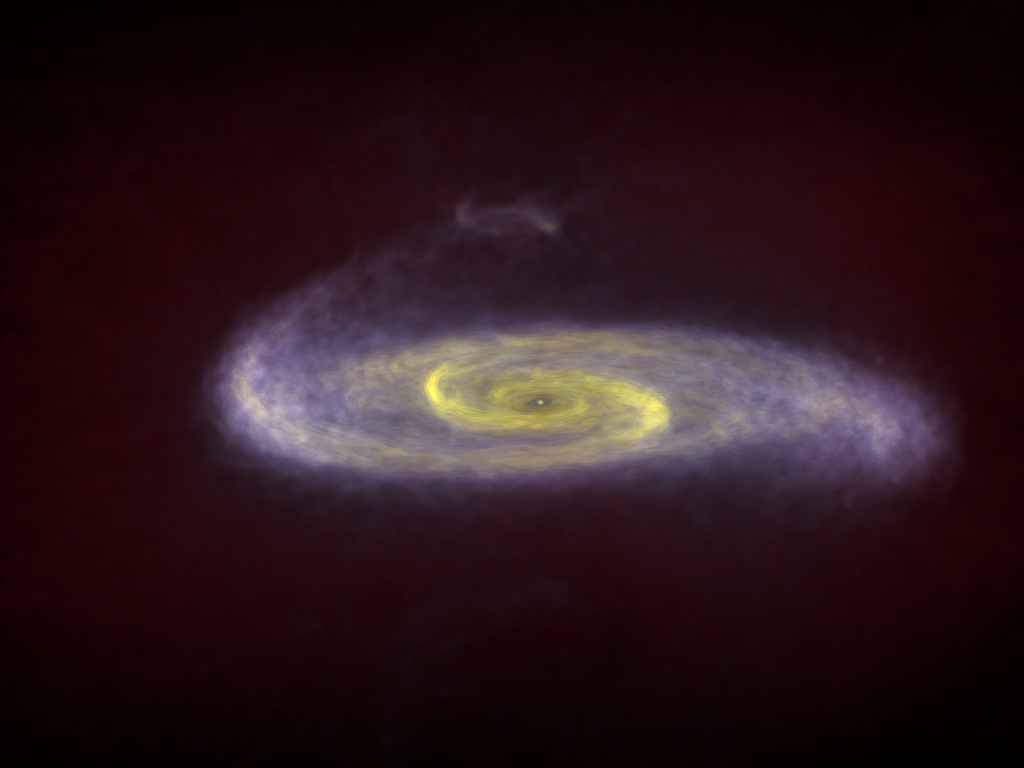
Interstellar medium (ISM) of galaxies is a complex environment composed of various gas phases, magnetic fields (MF) and cosmic rays (CR). Numerical simulation techniques involving hydro (HD) and magnetohydrodynamics (MHD) algorithms are commonly used in theoretical studies of dynamical processes leading to star formation in the turbulent interstellar medium. Circumstances relevant for stars formation involve gravitational instability, turbulence, shock waves, radiative cooling, phase transitions in the interstellar gas, magnetic field and cosmic ray driven instabilities.
The MHD group of Toruń Centre for Astronomy specialises in modelling of dynamical processes in the magnetised ISM. The group is developing an advanced MHD simulation code PIERNIK, which is a multipurpose, multifluid magnetohydrodynamics (MHD) code (Hanasz et al. 2010). PIERNIK is publically available from git repository
https://github.com/piernik-dev/piernik.git
The numerical algorithms of PIERNIK include a robust and efficient Relaxing Total Variation Diminishing (RTVD) MHD algorithm, as well as the recently implemented HLLD and MUSCL Riemann solvers. The code is equipped with a multigrid and multipole POISSON solvers, cosmic ray transport algorithm and Adaptive Mesh Refinement (AMR) module. The code can be used to study a variety of astrophysical problems by means of numerical simulations.
The summer student will become familiar with:
- several pre-defined test problems in the PIERNIK code repository (sedov explosion, gravitational instability, cooling instability)
- the basic numerical methods of fluid simulations implemented in PIERNIK code
- the main simulation parameters controlling grid-type fluid simulations.
- basic techniques of HPC parallel computing
- basics of git repository
The possible activities proposed for summer students include:
- Numerical simulations of supernova driven interstellar medium in the presence of radiative cooling.
- Numerical simulations of gravitational instability in a rotating, magnetised galactic disk.
| Supervisor: | Michał Hanasz (mhanasz[at]umk.pl) |
| Time: | August/September |
^ ^ ^ ^ ^
Optical atomic clocks and ultra-cold matter
The Nobel Prize winner in Physics, Arthur Shawlow used to say to his students at Stanford University: “Never measure anything but frequency!”. Indeed, in the story of mankind the frequency measurements were always those measurements that where the most accurate. One of the reason is that digital, discrete and finite counting the number of cycles during a given time unit is immune to most of the uncertainty sources seen in other measurements.
Optical atomic clocks still are the most precise scientific instrument available to humanity. They accuracy and stability reached eighteen significant digits. Therefore, the optical atomic clocks are one of those experiments that pushes the boundaries of knowledge. They are used, e.g., for search for variation of fundamental constants, validating the assumption of the Standard Model, and, as we show recently, even in detection of Dark Matter. The cost of their construction and maintenance, however, is many times lower and the needed research team is smaller in comparison to other, great experiments that enlarge our knowledge on structure and history of our Universe.
We are currently looking for students to participate in the following studies: topological defect Dark Matter detection with active optical atomic clock, development of new types of optical lattice traps and ultra-cold molecules creation by photoassociation spectroscopy. These tasks require basic knowledge of cosmology, high energy physics, the atomic and molecular physics, and experimental skills.
| Supervisor: | Michał Zawada (zawada[at]fizyka.umk.pl) |
| Time: | 19 June - 31 July |
^ ^ ^ ^ ^
Cavity-enhanced direct frequency comb spectroscopy
Cavity-enhanced direct frequency comb spectroscopy (DFCS) is a technique utilizing the inherent frequency stability and the broadband operation of laser frequency combs to probe optical molecular resonances. This technique facilitates rapid measurements of spectra of several molecules at once, which makes it a promising tool for: human breath analysis, industrial and biomedical process monitoring and measuring dynamics of chemical reactions. In conjunction with optical enhancement cavities it enables precise measurements of weak resonances or trace gas detection with ppb and ppt concentration levels.
The student will be involved in development of novel CE-DFCS techniques utilizing either so called VIPA spectrometer or Fourier-transform spectrometer with instrumental-line-shape-free method.
^ ^ ^ ^ ^
Cavity ring-down spectroscopy
Cavity ring-down spectroscopy (CRDS) is one of the most sensitive spectroscopic techniques and has been recognized as an ideal tool for providing reference data for satellites monitoring the Earth’s atmosphere. The use of the high-finesse optical cavity extends the optical pathlength to several kilometers (the cavity is about 1 meter long) and allows precise measurements of weak absorption spectra important in atmospheric studies (O
2, CO, CO
2, etc.).
The student will be involved in the project concerning development of the ultra-sensitive CRDS spectrometer. In particular his task will be implementation of an active stabilization of the length of the optical cavity. The cavity resonances will be locked to the I
2-stabilized Nd:YAG laser which provides the ability to control the distance between the cavity mirrors at the sub-nm level. The student will familiarize with construction of optical setups in NIR range as well as with different locking techniques.
^ ^ ^ ^ ^
Trapped ions
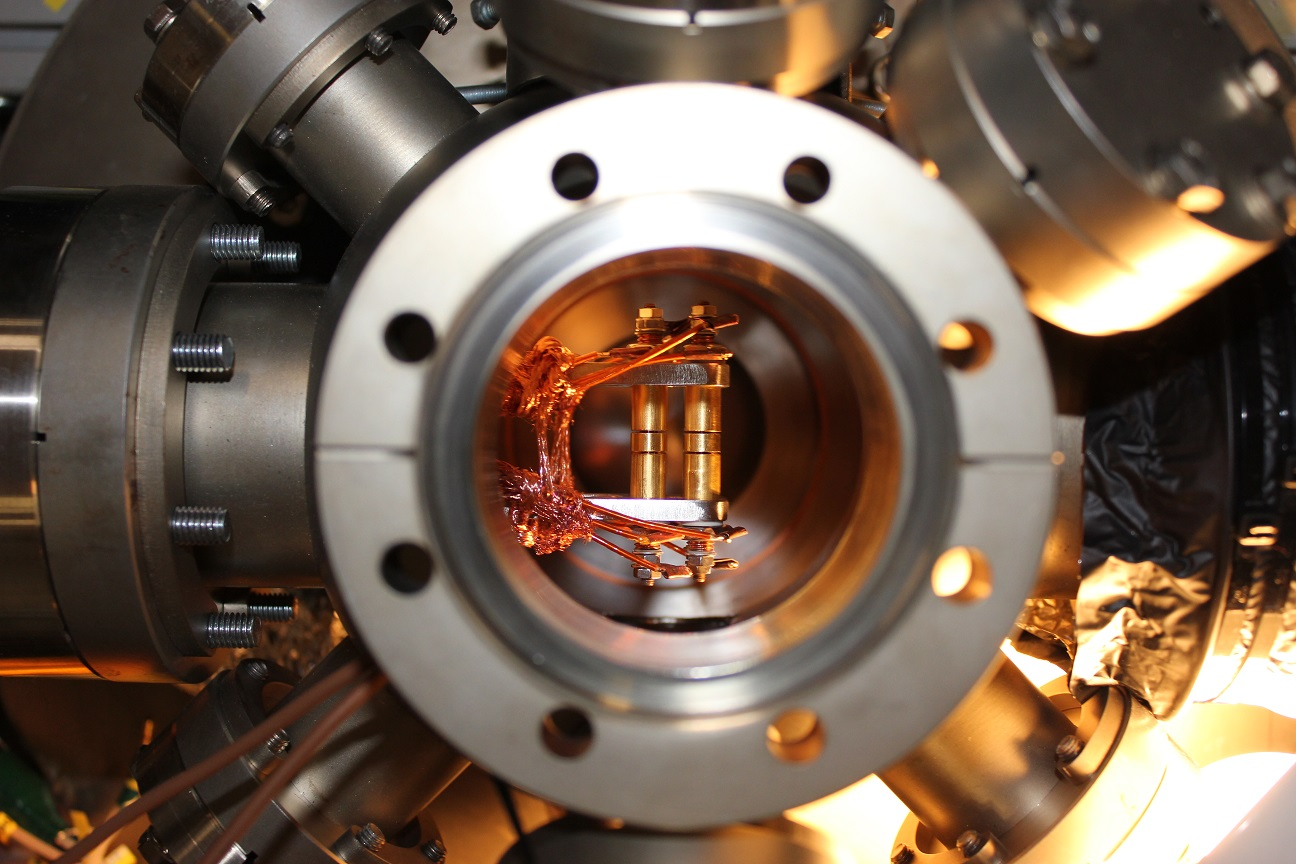
Ion trapping is an experimental technique commonly applied in atomic and molecular spectroscopy, cold chemistry, quantum information, etc. In the FAMO lab experiment some multi-species ionic crystals, built of calcium and molecular ingredients, are investigated.
Summer student will be allowed to spent their time on some of following activities: numerical simulations of molecular dynamics of ion ensemble, running the experiment, data analysis, construction of macroscopic models of ion trap.
^ ^ ^ ^ ^
Graphene photosynthesis
Graphene needs no introduction, it is one of the mostly studied materials today. We apply grapheme and its derivatives as acceptor of energy and charge in assemblies containing naturally evolved photosynthetic complexes. Fabrication of such structures is a challenge, and the student will be involved in some of the fabrication steps. The core of the project hoever will be to carry out fluorescence imaging experiments in the visible spectral range, in order to search for charge transfer is such hybrid nanostructure and elucidate the effect of various parameters on the efficiency of this process.
^ ^ ^ ^ ^
Plasmonic networks
Plasmonic networks based on metallic nanostructures are considered to be a promising alternative for integrated optoelectronic circuits. In particular metallic nanowires made of gold or silver can be used to propagate and distribute the energy via so-called plasmonic excitations (oscillations of free electrons). As the nanowires are tens-of-microns long, it is possible to imagine a plasmonic network, where variety of effects can be studied.
The student will carry out a research project focused on imaging luminescence of nanocrystals in the presence of silver nanowires using a custom-made two-objective fluorescence microscope assembled to enable non-local experiments, where one end of the nanowire is illuminated, while the observation is taking place at the other one. Among specific effects we intend to focus on methods and techniques of generation and controlled propagation of plasmonic excitations, networks attenuation, sensitivity to polarization, etc.
^ ^ ^ ^ ^
Low-energy electron scattering from gas-phase atoms and molecules
Electron scattering is one of the most powerful tools for probing properties of single atoms and molecules. In particular the collisions of low-energy (very slow) electrons with atomic and molecular targets is a fascinating way of studying quantum-mechanical features of the nanoscale world. However, the realization of scattering experiments is not an easy task due to the technical difficulties related with formation of stable low-energy monochromatic electron beams. This project will be connected with the problem of construction and optimization of new experimental system for low-energy electron scattering. The possible activities can involve (optional):
- design and simulation of electrostatic lens systems in SIMION 8.1 software package and tests in real experiments;
- implementation and automation of an electron detection system (LabView knowledge required for this task);
- test measurements of scattering cross-sections for simple targets.
| Supervisor: | Kamil Fedus (kamil[at]fizyka.umk.pl) |
| Time: | tbd |
^ ^ ^ ^ ^
Quantum chemistry: molecular interactions and collisions
The quantum chemistry is capable to predict many important properties of gases from the first principles, with no experimental feedback. It provides a crucial guidance for spectroscopic and ultra-cold matter experiments, but more recently it has become a very important tool in studies of condensed matter physics, drug design and biochemistry.
In the project we will focus on fundamental issues of the theory of molecular interactions and their collisions. The main interest of the is to study the atom-molecule or atom-excited state atom which are highly relevant in the ultra-cold physics and chemistry.
There are two major problems in studies and student will tackle one of them (whatever she/he prefers): i) the interaction potential needs to be evaluated which involves application (or sometime, development) of quantum chemistry methods, ii) the collision calculations need to be performed by solving the nuclear Schroedinger equation. A specific system to start with will be potassium atom interacting with dysprosium atom, however, I can see a lot of flexibility in selecting potential system of our study.
Potential student should be familiar with linux system, and one programming language, like matlab or python. Knowledge of any quantum chemistry program is also welcome, but not essential.
| Supervisor: | Piotr Żuchowski (pzuch[at]fizyka.umk.pl) |
| Time: | last week of July till end of August (negotiable) |
^ ^ ^ ^ ^
Quantum nanophotonics
Plasmonic nanostructures show the remarkable ability to concentrate light in subwavelength domains of space. If quantum systems, such as molecules or quantum dots, are positioned in such nanoscopic hot-spots, their interaction to enhanced electromagnetic fields becomes significantly more intense. For this reason, exploiting plasmonic nanostructures to drive light-matter interactions unlock effects otherwise hardly observable, such as carrying molecular interactions at ranges increased by orders of magnitude or generation of exotic photons in electric-dipole-forbidden transitions.
We expect basic knowledge on quantum mechanics and electrodynamics, fluent English and motivation.
Possible activities proposed for summer students may focus on analytical or numerical investigations, depending on the student’s individual skills and expectations.
^ ^ ^ ^ ^
Ultrasensitive Optical Probing of Elastic Properties of Ocular Structures
The human eye is a complex and dynamic optical structure enabling visual perception, i.e. conversion of light into electrical signals that are later processed by the brain. In clinical practice, imaging of the anterior segment of the eye has been traditionally carried out with slit lamp biomicroscopy. However, anterior segment imaging is currently a rapidly advancing field of ophthalmology and provides tools that supplement well-established modalities like ultrasound biomicroscopy, confocal microscopy, Scheimpflug imaging, corneal topography etc. Another field of intensive studies includes extraction and probing of visco-elastic properties of the ocular structures. This technique, known as elastography, is based on the measurement of the tissue displacement due to its mechanical loading (stress).
Ophthalmic elastography is the foundation of diagnosis and management of ocular diseases such as keratoconus, and enables proper planning of the surgical manipulations (e. g. LASIK). Additionally, expanding knowledge about ocular biomechanics is extremely important for the advances in the reliable evaluation of the intraocular pressure, thus for more effective management of the glaucoma.
In this project, we develop interferometric technology for vibration detection. The student will assess feasibility of the ultrasensitive method of measurement of the reaction of ocular structures to mechanical excitation. We seek a motivated student with basic knowledge of optics and interferometry. Skills in signal processing and programming are advantageous.
| Supervisor: | Ireneusz Grulkowski (igrulkowski[at]izyka.umk.pl) |
| Time: | July / August (to be specified) |
^ ^ ^ ^ ^
High-speed High-resolution Microscopy with Vector Beams
Optical microscopy revolutionized biomedicine in recent years. However, in spite of the recent technology advances, modern optical imaging methods still exhibit several challenges which are mainly related to the ability of the system to distinguish details of the imaged object and stem from the properties of the light beam propagation (diffraction). The advances in optical engineering enables application of different illumination schemes to improve the performance of imaging instruments.
In this project, we would like to combine vector beams (optical beams with spatial distribution of polarization) with high-resolution microscopy to compare the performance of this approach with regular illumination. High-speed spatial light modulator and polarization optics will be used to develop the microscope with vector beams. The student will be also involved in determination of performance parameters of imaging systems. We seek a motivated person with basic knowledge of optics and interferometry. Skills in signal processing and programming are advantageous.
| Supervisor: | Ireneusz Grulkowski (igrulkowski[at]izyka.umk.pl) |
| Time: | July / August (to be specified) |
^ ^ ^ ^ ^
Retrieving sample pressure and temperature from spectral data
Spectroscopy is a powerful and sensitive tool for measurement of various properties of matter. It can be used for determination of sample composition, including trace gas detection at ppb and ppt level. It is also used for retrieval of sample’s thermodynamic properties such as pressure and temperature, which is especially important in the atmospheric research. Such research requires high quality reference data obtained in laboratory conditions.
Student will be involved in analysis of high quality spectra of small atmospheric molecules like O2 in gaseous samples. He or she will learn about spectral line shapes and spectral databases such as HITRAN and GEISA.
^ ^ ^ ^ ^
Quantum information in a time domain
Entanglement is a basic block of quantum communication and computation protocols. In practice, the entanglement can be produced by means of the parametric down-conversion process where one photon decays into a pair of photons. The purely quantum mechanical features of a photon pair in conjunction with novel detection techniques can be used to enhance the quantum communication protocols.
The student will work on experiment and/or theory of a new quantum communication protocol based on time resolved single photon detection techniques. This will be a chance to gain experience in working with the state-of-the-art superconducting single photon detectors, single photon sources, and data acquisition and analysis systems.
^ ^ ^ ^ ^
Functional Optical Coherence Tomography
Optical Coherence Tomography (OCT) is a technique that allows to visualize three-dimensional structure of tissues and cells. Its high imaging speed allows for tracking various properties of these objects as cytoplasmic dynamic, chemical content or mechanical properties using only information carried by scattered light.
The student will participate in developing experimental methods and data processing schemes to extract those properties from data obtained with various types of OCT devices.
^ ^ ^ ^ ^
High-speed Scanning Laser Ophthalmoscope
Scanning Laser Ophthalmoscopy (SLO) is a technique allowing to image the fundus of the human eye with high temporal resolution. It compromises image size with refresh rate. The purpose of this project will be to examine the tradeoffs between imaging speed and image quality.
The student will be involved in building a simple SLO system equipped with fast resonant scanning system and explore its limitations.
^ ^ ^ ^ ^
